Early maturing drought-resistant potato variety "Red Lady" for long storage
One of the conditions for a good potato harvest is the right variety, suitable for the region's climate and soil. The universal variety Red Lady is planted throughout our country - in small plots and farm fields. This is not surprising: it is able to quickly adapt to any climate and brings a rich harvest even in adverse conditions.
The content of the article
Characteristics of the variety
Consider the description of the Red Lady potato variety in more detail (with photo).
The plant has a medium-sized bush, erect, spreading. The leaves are medium-sized, dark green, emerald green. The stem is powerful, the root system is well developed. Flowering culture is a real decoration of the garden. Inflorescences are medium-sized, lavender in color.
The plant's genes have a high resistance to such dangerous diseases as scab, golden nematode, viral diseases. But seedlings are vulnerable to late blight.
The crop is drought tolerant and thrives in hot climates.
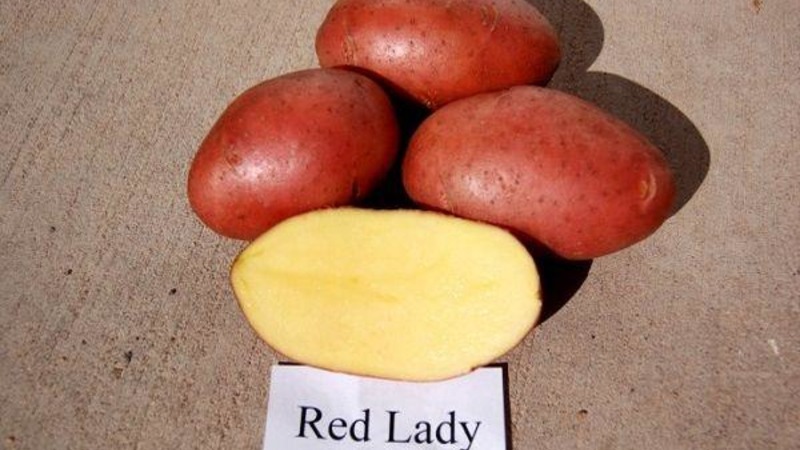
Origin and development
Potato variety Red Lady (translated from English - "Red Lady") appeared thanks to German specialists. As a result of their labors, a high-yielding, well-adapted to various climates and early-maturing variety was obtained, which successfully passed the tests.
After confirming the indicated qualities, the Red Lady potato was entered into the State Register of Russia in 2008.
Chemical composition, trace elements and vitamins
The biological value is determined by the content of ascorbic acid (vitamin C) and the full group of vitamins B. Also, the content of iron, vegetable proteins and organic acids - citric and oxalic - is noted in the tubers. Of the trace elements, potassium and phosphorus salts are present. The starch content does not exceed 15%.
Ripening period
Ripening early - the crop is harvested 50 days after landing... The growing season is extended, so the crop intended for long-term storage is harvested no earlier than 90 days.
Yield
The yield varies within 170-300 c / ha... This indicator is influenced by the systematic application of dressings and the duration of daylight hours. The culture loves fertile soil: the higher the saturation of the soil with useful substances, the better the fruiting.
Up to 14 tubers are formed on one seedling. All potatoes are large, leveled, there are few unmarketable little things.
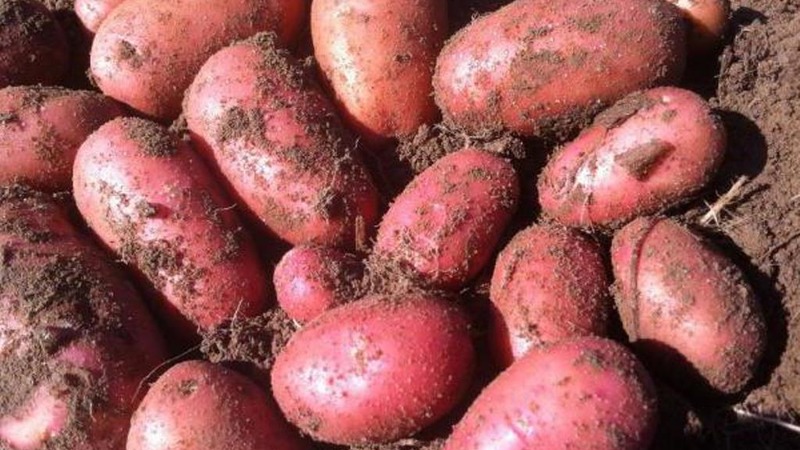
Characteristics of tubers
The average weight of a potato is 130-150 g, the shape is oblong-rounded, the peel is even, smooth, there are few eyes, the depth is superficial. The color is red-pink, intense. According to reviews, the taste is excellent. The pulp is light yellow, firm.
Thanks to the thin but strong peel, the tubers are stored for a long time and withstand long transportation without losing their presentation.
The variety is versatile in application. The tubers withstand any heat treatment without darkening the pulp. They are also great for making chips and French fries.
The photographs show the Red Lady potatoes.

Growing regions and climate requirements
For full growth and development, the plant does not require certain climatic conditions. Potatoes are planted throughout Russia. It is successfully bred not only in the southern regions, but also in the Far East, in the Volgo-Vyatka, Central and Caucasian regions. Also, the culture is widely popular in the CIS countries.
Advantages and disadvantages
Red Lady potatoes have both positive and negative sides.
Let's start with the benefits:
- takes root in any climate;
- unpretentious in care;
- early maturity;
- high rate of fruiting;
- high resistance;
- drought resistance;
- excellent taste;
- long preservation;
- long-term transportation;
- versatility in application.
The disadvantages include dependence of the number of crops on top dressing.
What is the difference from other varieties
The main difference between the Red Lady potato variety is that it is able to fully grow and develop even in adverse weather conditions. At the same time, it retains its taste and presentation.
Features of planting and growing
The culture is unpretentious, its cultivation is within the power of both an experienced gardener and a beginner.
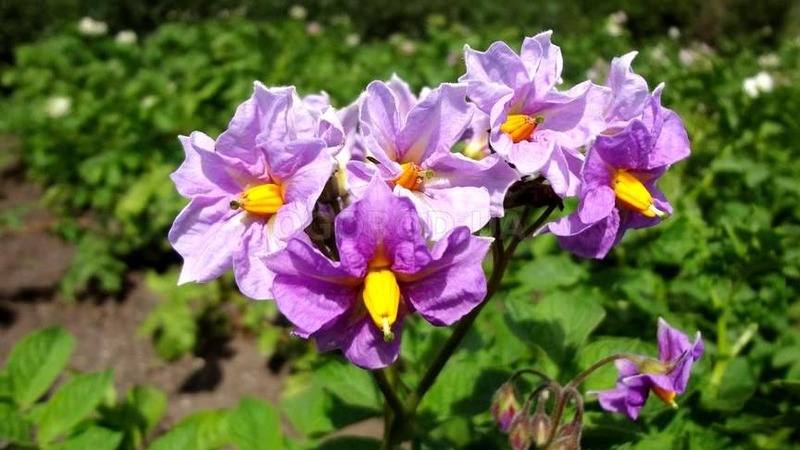
Preparing for landing
They begin to plant potatoes when the soil temperature reaches + 10 ° C - earlier you should not rush to planting, otherwise you can ruin all the seeds.
Preparation for planting begins in a month. To obtain seedlings, only germinated seed is planted.
The weight of potato tubers intended for sowing should be 70-100 g. Potatoes are carefully inspected for visible defects, leaving only undamaged ones.
The seed is germinated in a bright room at a temperature of at least + 15 ° C. Greening tubers during germination indicates an increased content of toxic solanine in the skin. When planted, this will protect the tubers from many pests.
Reference. Solanine is a poisonous glycoside that is produced in plants of the nightshade family. It is especially dangerous for rodents, therefore field mice avoid such landings.
Before sowing, the tubers are treated with growth stimulants "Kornevin" or "Bioglobin".
Ground requirements
For rapid germination, potatoes require loose, fertile soil. Therefore, the soil is dug up twice with the introduction of humus and wood ash. The second not only saturates the earth with useful elements, but also prevents the growth of fungi. The soil is dug up in the fall after harvesting and in the spring before sowing.
For ease, fine river sand is added to the soil, which acts as a baking powder. If the soil is acidic, adding dolomite flour or slaked lime will help to deoxidize it.
Reference. The acidity of the soil is increased if horse sorrel, blueberries, lupines grow on the site.
Timing, scheme and technology of landing
Potatoes are planted when the ground warms up to + 10 ° C and the threat of recurrent frosts has passed. The culture does not tolerate a sharp cold snap - it negatively affects its growth. Therefore, sowing work is carried out from the last days of April to the end of May, depending on the climatic characteristics of the region.
When planting, 35 cm is left between the seedlings, 55-65 cm between the rows. The depth of the holes is no more than 10 cm. The tubers are planted with sprouts up and sprinkled with wood ash. Then they sprinkle it on top with earth, tamp it, water it and mulch - for this, sawdust or straw is used.
Reference. Mulch protects crops from ground pests penetrating the holes and retains moisture in the beds.
The nuances of care
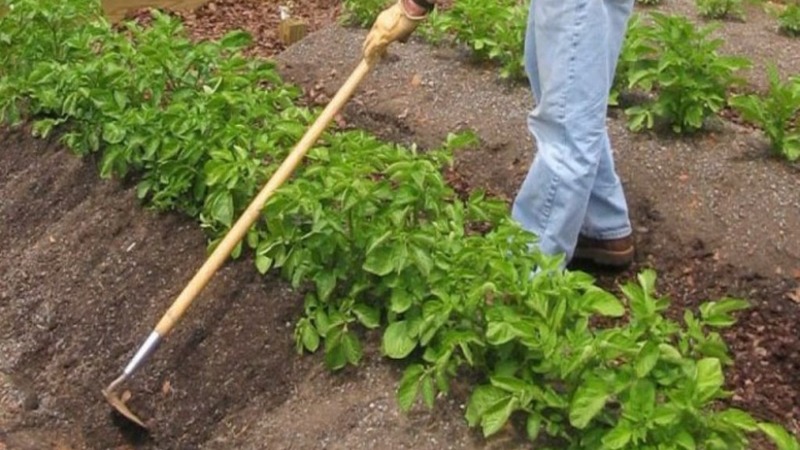
Further care consists of watering, weeding, hilling and top dressing.
Watering mode
Due to its resistance to heat, the Red Lady variety does not need abundant watering. Only during flowering and formation of tubers, seedlings will need more water: during this period, at least 3 liters of water are poured under each of them. In dry weather, mulching will keep the beds moist by inhibiting evaporation.
Top dressing
For full development and a rich harvest, potatoes are fed at least three times.
Two weeks after germination, the first feeding with urea is performed. Dissolve 500 g of urea in 10 liters of water and pour 0.5 liters under each bush. With poor growth of seedlings, at the initial stage, fertilizing with nitrogenous substances is carried out, accelerating their growth.
Before flowering, the plant is fed with a full range of minerals with a predominant phosphorus content.
The third feeding is carried out three weeks before harvest. 30 g of superphosphate and 250 g of slurry are dissolved in a bucket of water.
Weeding and hilling
It is most convenient to weed the beds on damp ground. After removing weeds, the soil is loosened, improving its air permeability.
Hilling is carried out at least twice per season. Thanks to this procedure, the yield of the crop is increased, as it stimulates the formation of new roots. It is not difficult to huddle the seedlings; for this, the earth is raked with a hoe into the beds from row spacings.
Reference. High hilling prevents ground insect pests from penetrating the roots.
Disease and pest control
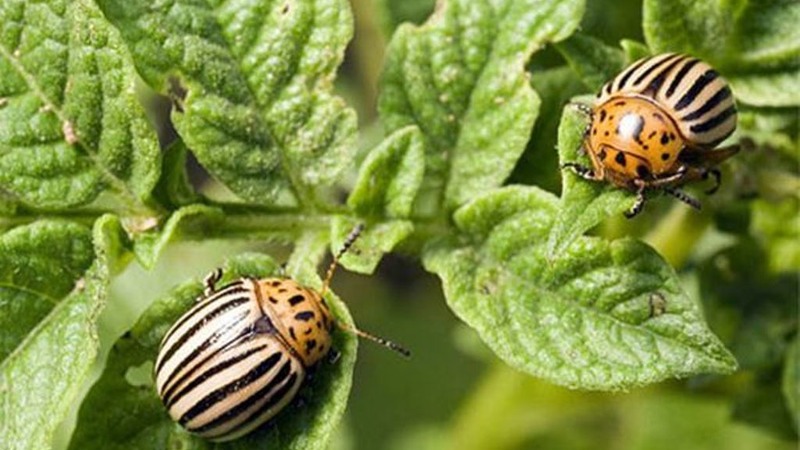
Late blight is a common fungal disease that often affects plants of the Solanaceae family. It destroys green mass and tubers. The fungus spreads quickly in conditions of high humidity and temperature. Therefore, it is recommended to treat watering wisely. The disease is difficult to cure, therefore, immediately after sowing, prophylaxis begins.
Wood ash, which is sprinkled on the seed, protects the tubers until germination. Then the two-week seedlings are sprayed with the fungicide "Fitosporin". The drug is known to most gardeners as a reliable protection against fungal diseases. Spraying is carried out systematically, but not more often than once a month.
Brown bacterial rot, also a fungus, occurs with improper care. The highest period of activity occurs at the time of flowering. Compliance with the rules of crop rotation and the introduction of timely fertilizing, thanks to which the immunity of plants is strengthened, will help prevent brown rot on the beds.
Of the pests that pose the greatest danger, Colorado beetles are isolated. They destroy landings with lightning speed. The pest is not afraid of the cold, he successfully survives them underground.
With a small number of beetles, they are harvested by hand, carefully examining the seedlings from all sides. If there are a lot of them, they use insecticides - for example, "Confidor".
Harvesting and storage
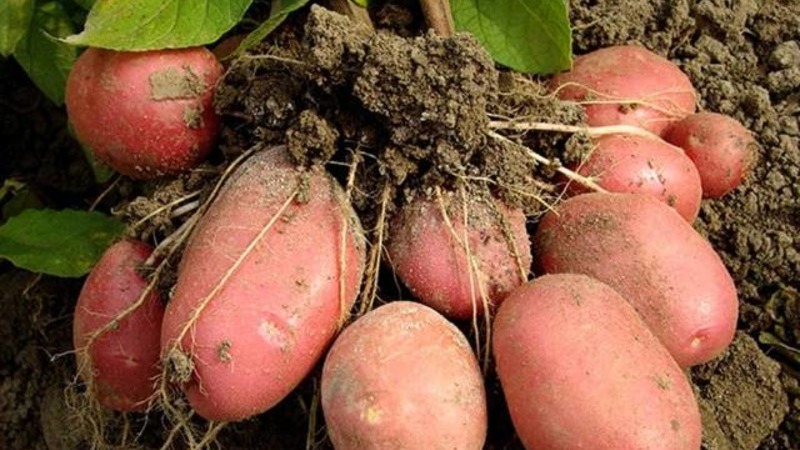
Harvesting of young potatoes begins 50-55 days after planting. But they do not store it for a long time - they immediately eat it.
How and when to clean
Harvesting begins in late August - early September. Before that, the tops are mowed, leaving no more than 10 cm. The crop is carefully dug up with a pitchfork or a shovel and left outside for 3-4 hours to dry. In cloudy weather, it is better to remove it under a canopy. After harvesting, the greens are burned, the soil is dug up.
As soon as the tubers are dry, they are carefully examined for damage or darkening and prepared for long-term storage.
Storage features
Ripe crops are stored in wooden boxes in a dry, dark, cool and well-ventilated area. The optimum air temperature should be 4-5 ° C.
Reference. For greater safety of tubers, they are treated with copper sulfate: 2 g of powder per 10 liters of water.
What can be the difficulties in growing
According to vegetable growers, there are no serious difficulties in growing: the variety is unpretentious. But there are nuances, the implementation of which will increase the yield.
According to the rules of crop rotation, potatoes are planted in the place where cereals, carrots, beet and legumes. These plants do not deplete the soil, but, on the contrary, saturate it with useful substances.
Mineral fertilizers should not be applied to acidic soil as top dressing. Mixing with an acidic environment, they lose some of their properties.In such soil, it is better to feed the plants with organic matter.
Tips from experienced gardeners and variety reviews
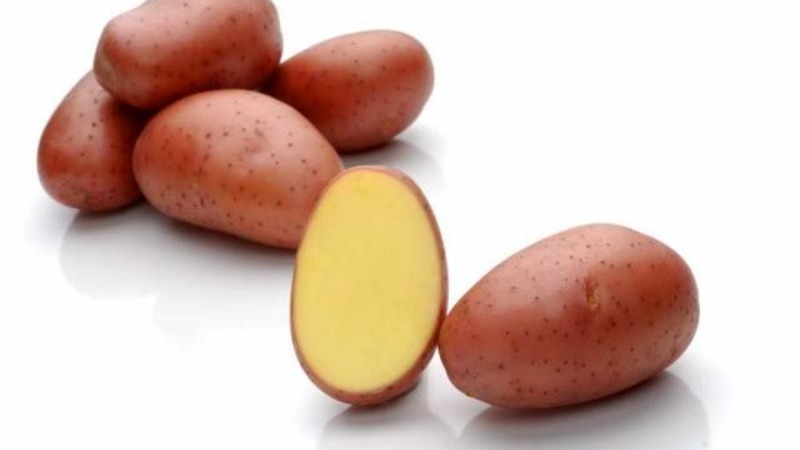
A few tips for caring for a crop will help not only a beginner, but also an experienced gardener:
- It is not worth planting various varieties next to it, as cross-pollination will occur and the plants will reduce varietal indicators.
- Landing is best done in a checkerboard pattern. This method will make it easier to care for the growing season and harvest.
Gardeners note only positive aspects in the Red Lady variety.
Rostislav, Zaporozhye: “I've been growing Red Lady since last summer, the harvest was a success. I collected 460 centners from two hectares. I sold most of it to wholesalers. Of course, I also leave myself, so that it will be enough until spring. I cook with potatoes and first and second courses. The taste is excellent, I like it. "
Irina, Voronezh: “I have been growing vegetables for many years. I found out about the Lady potatoes, planted them and was not disappointed. The potatoes are tasty, not watery. The color is beautiful, the peel is strong. I especially like its early maturity, after 1.5-2 months you can taste your young potatoes. "
Read also:
Medium early potato variety "Krasavchik" with amazing taste.
Conclusion
The unpretentious Red Lady potatoes are grown not only on personal plots, but also on an industrial scale. The ripe crop is in high demand and is quickly sold. The variety is resistant to many diseases, the potato grows well even in adverse weather conditions and quickly adapts to drought.